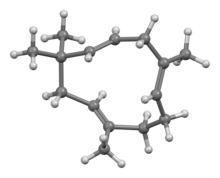
| |

| |
| Names | |
|---|---|
| IUPAC name
[1(11)E,4E,8E]-Humula-1(11),4,8-triene
| |
| Systematic IUPAC name
(1E,4E,8E)-2,6,6,9-Tetramethylcycloundeca-1,4-8-triene | |
| Other names
alpha-Caryophyllene; 3,7,10-Humulatriene
| |
| Identifiers | |
3D model (JSmol)
|
|
| ChEBI | |
| ChEMBL | |
| ChemSpider | |
| ECHA InfoCard | 100.027.106 |
PubChem CID
|
|
| UNII | |
CompTox Dashboard (EPA)
|
|
| |
| |
| Properties[1] | |
| C15H24 | |
| Molar mass | 204.357 g·mol−1 |
| Appearance | Pale yellowish green clear liquid |
| Density | 0.886 g/cm3 |
| Melting point | < 25 °C (77 °F; 298 K) |
| Boiling point | 106 to 107 °C (223 to 225 °F; 379 to 380 K) at 5 mmHg |
| Hazards | |
| Lethal dose or concentration (LD, LC): | |
LD50 (median dose)
|
>48 mg/kg |
| Safety data sheet (SDS) | MSDS |
Except where otherwise noted, data are given for materials in their standard state (at 25 °C [77 °F], 100 kPa).
| |
Humulene, also known as α-humulene or α-caryophyllene, is a naturally occurring monocyclic sesquiterpene (C15H24), containing an 11-membered ring and consisting of 3 isoprene units containing three nonconjugated C=C double bonds, two of them being triply substituted and one being doubly substituted. It was first found in the essential oils of Humulus lupulus (hops), from which it derives its name.[2] Humulene is an isomer of β-caryophyllene, and the two are often found together as a mixture in many aromatic plants.
- ^ Merck Index, 12th Edition, 4789
- ^ Glenn Tinseth, "Hop Aroma and Flavor", January/February 1993, Brewing Techniques. <http://realbeer.com/hops/aroma.html> Accessed July 21, 2010